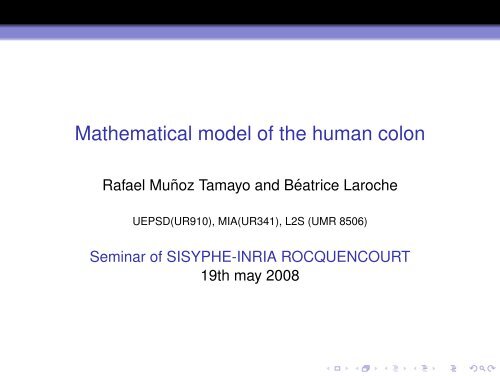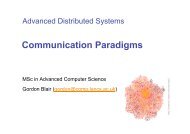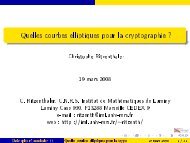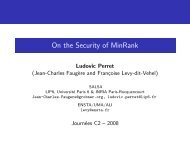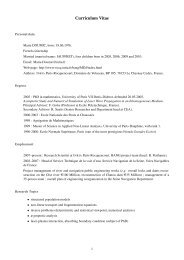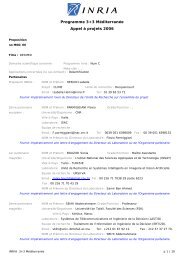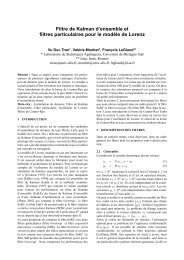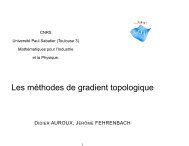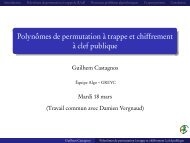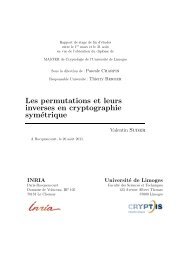Mathematical model of the human colon - Inria
Mathematical model of the human colon - Inria
Mathematical model of the human colon - Inria
You also want an ePaper? Increase the reach of your titles
YUMPU automatically turns print PDFs into web optimized ePapers that Google loves.
<strong>Ma<strong>the</strong>matical</strong> <strong>model</strong> <strong>of</strong> <strong>the</strong> <strong>human</strong> <strong>colon</strong><br />
Rafael Muñoz Tamayo and Béatrice Laroche<br />
UEPSD(UR910), MIA(UR341), L2S (UMR 8506)<br />
Seminar <strong>of</strong> SISYPHE-INRIA ROCQUENCOURT<br />
19th may 2008
The Context<br />
Thèse<br />
Director: Eric Walter (L2S)<br />
Supervisors:<br />
Béatrice Laroche (L2S)<br />
Marion Leclerc (UEPSD-INRA Jouy en Josas)<br />
Kiên Kiêu (MIA-INRA Jouy en Josas)<br />
Partner: Jean Philippe Steyer (LBE-INRA Narbonne)<br />
Project: AlimIntest ANR
Capital: Bogotá<br />
Population: 45 millions<br />
Language: Spanish<br />
Surface: 1 141 748 km 2<br />
My Background<br />
Chemical Engineer.<br />
Universidad Nacional de<br />
Colombia. 2004<br />
Master in Automatic<br />
Control.Universidad<br />
Nacional de Colombia. 2006<br />
Now: PhD student in Physics<br />
(2nd year. 27th november).<br />
Université Paris-Sud<br />
INRA Jouy en Josas<br />
L2S-Supélec
Plan<br />
1 The Human Colon<br />
2 Motivation<br />
3 <strong>Ma<strong>the</strong>matical</strong> <strong>model</strong><br />
Phenomena<br />
Hydraulic Representation<br />
Transport Flux<br />
Biological Reactions<br />
State equations<br />
Model Characterization<br />
4 Validation framework<br />
Modelling <strong>of</strong> invitro homoacetogenesis<br />
5 Perspectives and Conclusions
The Human Colon Motivation <strong>Ma<strong>the</strong>matical</strong> <strong>model</strong> Validation framework Perspectives and Conclusions<br />
Physiology<br />
Function target: get energy through<br />
Anaerobic Degradation <strong>of</strong> complex<br />
carbohydrates:<br />
Alimentary fibers<br />
Mucus: endogenous source,<br />
secreted by epi<strong>the</strong>lial cells<br />
Microbial community: + 800 species.<br />
Two diferents microhabitats: Lumen<br />
and Mucus
The Human Colon Motivation <strong>Ma<strong>the</strong>matical</strong> <strong>model</strong> Validation framework Perspectives and Conclusions<br />
Interactions host-bacterial: starting<br />
to be understood<br />
Microbiota: role on <strong>human</strong> health<br />
Limitations in <strong>the</strong> experimentation:<br />
Uncultured bacteria<br />
Samples in some cases can not<br />
be representative: Ethical<br />
considerations<br />
An in silico <strong>model</strong> would<br />
be useful to:<br />
Improve <strong>the</strong> understanding <strong>of</strong> :<br />
Carbohydrate fermentation<br />
Impact <strong>of</strong> <strong>the</strong> microbiota on<br />
<strong>the</strong> stability <strong>of</strong> <strong>the</strong> digestive<br />
system<br />
Role <strong>of</strong> <strong>the</strong> microbiota on<br />
IBD, Obesity<br />
Study <strong>the</strong> influence <strong>of</strong> dietary<br />
regimes on <strong>human</strong><br />
gastrointestinal microbiota<br />
Design experiments both in vivo<br />
and in vitro
The Human Colon Motivation <strong>Ma<strong>the</strong>matical</strong> <strong>model</strong> Validation framework Perspectives and Conclusions<br />
Interactions host-bacterial: starting<br />
to be understood<br />
Microbiota: role on <strong>human</strong> health<br />
Limitations in <strong>the</strong> experimentation:<br />
Uncultured bacteria<br />
Samples in some cases can not<br />
be representative: Ethical<br />
considerations<br />
An in silico <strong>model</strong> would<br />
be useful to:<br />
Improve <strong>the</strong> understanding <strong>of</strong> :<br />
Carbohydrate fermentation<br />
Impact <strong>of</strong> <strong>the</strong> microbiota on<br />
<strong>the</strong> stability <strong>of</strong> <strong>the</strong> digestive<br />
system<br />
Role <strong>of</strong> <strong>the</strong> microbiota on<br />
IBD, Obesity<br />
Study <strong>the</strong> influence <strong>of</strong> dietary<br />
regimes on <strong>human</strong><br />
gastrointestinal microbiota<br />
Design experiments both in vivo<br />
and in vitro
The Human Colon Motivation <strong>Ma<strong>the</strong>matical</strong> <strong>model</strong> Validation framework Perspectives and Conclusions<br />
Interactions host-bacterial: starting<br />
to be understood<br />
Microbiota: role on <strong>human</strong> health<br />
Limitations in <strong>the</strong> experimentation:<br />
Uncultured bacteria<br />
Samples in some cases can not<br />
be representative: Ethical<br />
considerations<br />
An in silico <strong>model</strong> would<br />
be useful to:<br />
Improve <strong>the</strong> understanding <strong>of</strong> :<br />
Carbohydrate fermentation<br />
Impact <strong>of</strong> <strong>the</strong> microbiota on<br />
<strong>the</strong> stability <strong>of</strong> <strong>the</strong> digestive<br />
system<br />
Role <strong>of</strong> <strong>the</strong> microbiota on<br />
IBD, Obesity<br />
Study <strong>the</strong> influence <strong>of</strong> dietary<br />
regimes on <strong>human</strong><br />
gastrointestinal microbiota<br />
Design experiments both in vivo<br />
and in vitro
The Human Colon Motivation <strong>Ma<strong>the</strong>matical</strong> <strong>model</strong> Validation framework Perspectives and Conclusions<br />
Related works<br />
Microbial competition [Ballyk et al, 2001]<br />
VFA absorption [Minekus et al, 1999]<br />
Interaction Host vs Microbiota [Wilkinson, 2002]<br />
Fermentation in vivo and in vitro <strong>model</strong>s: [Leclerc et al,<br />
1997], [Macfarlane et al, 1998]<br />
Effect <strong>of</strong> transit time: [Child et al, 2006]<br />
None <strong>of</strong> <strong>the</strong>se <strong>model</strong>s integrate <strong>the</strong> physiology, <strong>the</strong><br />
bioreactions, <strong>the</strong> transport flux with <strong>the</strong> functional microbial<br />
diversity
The Human Colon Motivation <strong>Ma<strong>the</strong>matical</strong> <strong>model</strong> Validation framework Perspectives and Conclusions<br />
Premises<br />
The microbiota can be<br />
functionally represented<br />
The <strong>colon</strong> can be defined as a<br />
high-rate system:<br />
High biomass concentration:<br />
formation <strong>of</strong> aggregates in<br />
<strong>the</strong> mucus<br />
Resistance to hydrodynamic<br />
forces<br />
In spite <strong>of</strong> its geometry, <strong>the</strong>re<br />
are some factors that produce<br />
mixing:<br />
Peristaltic movement<br />
Shed <strong>of</strong> epi<strong>the</strong>lial cells<br />
Gas production<br />
The <strong>colon</strong> can be represented<br />
by a series <strong>of</strong> chemostats
The Human Colon Motivation <strong>Ma<strong>the</strong>matical</strong> <strong>model</strong> Validation framework Perspectives and Conclusions<br />
Premises<br />
The microbiota can be<br />
functionally represented<br />
The <strong>colon</strong> can be defined as a<br />
high-rate system:<br />
High biomass concentration:<br />
formation <strong>of</strong> aggregates in<br />
<strong>the</strong> mucus<br />
Resistance to hydrodynamic<br />
forces<br />
In spite <strong>of</strong> its geometry, <strong>the</strong>re<br />
are some factors that produce<br />
mixing:<br />
Peristaltic movement<br />
Shed <strong>of</strong> epi<strong>the</strong>lial cells<br />
Gas production<br />
The <strong>colon</strong> can be represented<br />
by a series <strong>of</strong> chemostats
The Human Colon Motivation <strong>Ma<strong>the</strong>matical</strong> <strong>model</strong> Validation framework Perspectives and Conclusions<br />
Premises<br />
The microbiota can be<br />
functionally represented<br />
The <strong>colon</strong> can be defined as a<br />
high-rate system:<br />
High biomass concentration:<br />
formation <strong>of</strong> aggregates in<br />
<strong>the</strong> mucus<br />
Resistance to hydrodynamic<br />
forces<br />
In spite <strong>of</strong> its geometry, <strong>the</strong>re<br />
are some factors that produce<br />
mixing:<br />
Peristaltic movement<br />
Shed <strong>of</strong> epi<strong>the</strong>lial cells<br />
Gas production<br />
The <strong>colon</strong> can be represented<br />
by a series <strong>of</strong> chemostats
The Human Colon Motivation <strong>Ma<strong>the</strong>matical</strong> <strong>model</strong> Validation framework Perspectives and Conclusions<br />
Premises<br />
The microbiota can be<br />
functionally represented<br />
The <strong>colon</strong> can be defined as a<br />
high-rate system:<br />
High biomass concentration:<br />
formation <strong>of</strong> aggregates in<br />
<strong>the</strong> mucus<br />
Resistance to hydrodynamic<br />
forces<br />
In spite <strong>of</strong> its geometry, <strong>the</strong>re<br />
are some factors that produce<br />
mixing:<br />
Peristaltic movement<br />
Shed <strong>of</strong> epi<strong>the</strong>lial cells<br />
Gas production<br />
The <strong>colon</strong> can be represented<br />
by a series <strong>of</strong> chemostats
The Human Colon Motivation <strong>Ma<strong>the</strong>matical</strong> <strong>model</strong> Validation framework Perspectives and Conclusions<br />
Phenomena
The Human Colon Motivation <strong>Ma<strong>the</strong>matical</strong> <strong>model</strong> Validation framework Perspectives and Conclusions<br />
Phenomena<br />
Hydraulic Representation
The Human Colon Motivation <strong>Ma<strong>the</strong>matical</strong> <strong>model</strong> Validation framework Perspectives and Conclusions<br />
Phenomena<br />
Transport Flux
The Human Colon Motivation <strong>Ma<strong>the</strong>matical</strong> <strong>model</strong> Validation framework Perspectives and Conclusions<br />
Phenomena<br />
Transport Flux
The Human Colon Motivation <strong>Ma<strong>the</strong>matical</strong> <strong>model</strong> Validation framework Perspectives and Conclusions<br />
Phenomena<br />
Biological Reactions
The Human Colon Motivation <strong>Ma<strong>the</strong>matical</strong> <strong>model</strong> Validation framework Perspectives and Conclusions<br />
Phenomena<br />
Biological Reactions
The Human Colon Motivation <strong>Ma<strong>the</strong>matical</strong> <strong>model</strong> Validation framework Perspectives and Conclusions<br />
State equations<br />
Liquid phase<br />
For <strong>the</strong> Lumen<br />
( ) ( ) ( )<br />
ẋi l qin<br />
= x l<br />
V i,in − qout<br />
x l Vm<br />
l V i + b i x m<br />
13<br />
l V i +<br />
l<br />
∑ νi,j l ρl j (1)<br />
j=2<br />
( ) ( )<br />
ṡi l qin<br />
= s l V i,in − qout<br />
s l 7<br />
l V i − γl i sl i + l<br />
∑ νi,j l ρl j − Ql i (2)<br />
j=1<br />
For <strong>the</strong> mucus<br />
ṡ m i<br />
ẋ m<br />
i<br />
= −b i xi m<br />
13<br />
+ ∑ νi,j m ρm j (3)<br />
j=2<br />
( )<br />
= γi l Vl<br />
sl i − γ<br />
V i m s m 7<br />
i + Γ i +<br />
m<br />
∑ νi,j m ρm j − Qi m (4)<br />
j=1
The Human Colon Motivation <strong>Ma<strong>the</strong>matical</strong> <strong>model</strong> Validation framework Perspectives and Conclusions<br />
State equations<br />
Gas phase<br />
( ) ( ) ( )<br />
ṡ g qgin<br />
i = s g qgout<br />
V i,in − s g Vl/m<br />
g V i + Q i g V g<br />
(5)<br />
Q i = k L a(S L,i − M i K H,i p gas,i ) (6)
The Human Colon Motivation <strong>Ma<strong>the</strong>matical</strong> <strong>model</strong> Validation framework Perspectives and Conclusions<br />
State equations<br />
Kinetic rates<br />
Process ↓ j<br />
Kinetic rate<br />
1 Hydrolysis ρ 1 = k hyd s 1<br />
2 Uptake sugars ρ 2 = µ max2<br />
s 2<br />
Ks 2 +s 2<br />
x 2<br />
3 Uptake pyruvate ρ 3 = µ max3<br />
s 3<br />
Ks 3 +s 3<br />
x 3<br />
4 Uptake succinate ρ 4 = µ max4<br />
s 4<br />
Ks 4 +s 4<br />
x 4<br />
5 Uptake lactate ρ 5 = µ max5<br />
s 5<br />
Ks 5 +s 5<br />
x 5<br />
6 Uptake hydrogen: Ac ρ 6 = µ max6<br />
s 6<br />
Ks 6 +s 6<br />
x 6<br />
7 Uptake hydrogen: CH 4<br />
s<br />
ρ 7 = µ 7 max7 Ks 7 +s 7<br />
x 7<br />
8 Decay <strong>of</strong> x su ρ 8 = k d8 x 2<br />
9 Decay <strong>of</strong> x py ρ 9 = k d9 x 3<br />
10 Decay <strong>of</strong> x sc ρ 10 = k d10 x 4<br />
11 Decay <strong>of</strong> x la ρ 11 = k d11 x 5<br />
12 Decay <strong>of</strong> x h2−ac ρ 12 = k d12 x 6<br />
13 Decay <strong>of</strong> x h2c h 4<br />
ρ 13 = k d13 x 7
The Human Colon Motivation <strong>Ma<strong>the</strong>matical</strong> <strong>model</strong> Validation framework Perspectives and Conclusions<br />
Model Characterization<br />
Number <strong>of</strong> state variables for each subsystem (Lumen / Mucus): 20 (17<br />
liquid phase + 3 gas phase)<br />
Number <strong>of</strong> state variables for each partition: 40 (2x20)<br />
Number <strong>of</strong> states variables for <strong>the</strong> whole system: 120 (40x3)<br />
Measuring variables<br />
Measures: related with <strong>the</strong> last section<br />
All <strong>the</strong> variables can not be measured at <strong>the</strong> same time<br />
Some variables: measured once<br />
Parameters: 321<br />
Reduction: 94. (Knowledge)<br />
Prior information<br />
Estimation
The Human Colon Motivation <strong>Ma<strong>the</strong>matical</strong> <strong>model</strong> Validation framework Perspectives and Conclusions<br />
Obstacles and Alternatives<br />
Phenonema not well defined, e.g<br />
transport <strong>of</strong> components between<br />
<strong>the</strong> subsystems, rheology<br />
Difficulty <strong>of</strong> measurements<br />
Availability <strong>of</strong> data is limited<br />
Limitations for in vitro<br />
experiments: most <strong>of</strong> <strong>the</strong> bacteria<br />
are uncultured<br />
Many studies are based on <strong>the</strong><br />
microbiota in fecal matter<br />
Microsensors and FISH in<br />
mucus: spatial distribution<br />
Studies on artificial systems<br />
Study <strong>of</strong> state observers<br />
Bayesian approach for parameter<br />
estimation<br />
16SrRNA and FISH techniques<br />
in vivo <strong>model</strong>s: inoculated axenic<br />
rodents, biopsy in mucus
The Human Colon Motivation <strong>Ma<strong>the</strong>matical</strong> <strong>model</strong> Validation framework Perspectives and Conclusions<br />
Obstacles and Alternatives<br />
Phenonema not well defined, e.g<br />
transport <strong>of</strong> components between<br />
<strong>the</strong> subsystems, rheology<br />
Difficulty <strong>of</strong> measurements<br />
Availability <strong>of</strong> data is limited<br />
Limitations for in vitro<br />
experiments: most <strong>of</strong> <strong>the</strong> bacteria<br />
are uncultured<br />
Many studies are based on <strong>the</strong><br />
microbiota in fecal matter<br />
Microsensors and FISH in<br />
mucus: spatial distribution<br />
Studies on artificial systems<br />
Study <strong>of</strong> state observers<br />
Bayesian approach for parameter<br />
estimation<br />
16SrRNA and FISH techniques<br />
in vivo <strong>model</strong>s: inoculated axenic<br />
rodents, biopsy in mucus
The Human Colon Motivation <strong>Ma<strong>the</strong>matical</strong> <strong>model</strong> Validation framework Perspectives and Conclusions<br />
Obstacles and Alternatives<br />
Phenonema not well defined, e.g<br />
transport <strong>of</strong> components between<br />
<strong>the</strong> subsystems, rheology<br />
Difficulty <strong>of</strong> measurements<br />
Availability <strong>of</strong> data is limited<br />
Limitations for in vitro<br />
experiments: most <strong>of</strong> <strong>the</strong> bacteria<br />
are uncultured<br />
Many studies are based on <strong>the</strong><br />
microbiota in fecal matter<br />
Microsensors and FISH in<br />
mucus: spatial distribution<br />
Studies on artificial systems<br />
Study <strong>of</strong> state observers<br />
Bayesian approach for parameter<br />
estimation<br />
16SrRNA and FISH techniques<br />
in vivo <strong>model</strong>s: inoculated axenic<br />
rodents, biopsy in mucus
The Human Colon Motivation <strong>Ma<strong>the</strong>matical</strong> <strong>model</strong> Validation framework Perspectives and Conclusions<br />
Obstacles and Alternatives<br />
Phenonema not well defined, e.g<br />
transport <strong>of</strong> components between<br />
<strong>the</strong> subsystems, rheology<br />
Difficulty <strong>of</strong> measurements<br />
Availability <strong>of</strong> data is limited<br />
Limitations for in vitro<br />
experiments: most <strong>of</strong> <strong>the</strong> bacteria<br />
are uncultured<br />
Many studies are based on <strong>the</strong><br />
microbiota in fecal matter<br />
Microsensors and FISH in<br />
mucus: spatial distribution<br />
Studies on artificial systems<br />
Study <strong>of</strong> state observers<br />
Bayesian approach for parameter<br />
estimation<br />
16SrRNA and FISH techniques<br />
in vivo <strong>model</strong>s: inoculated axenic<br />
rodents, biopsy in mucus
The Human Colon Motivation <strong>Ma<strong>the</strong>matical</strong> <strong>model</strong> Validation framework Perspectives and Conclusions<br />
Strategy
The Human Colon Motivation <strong>Ma<strong>the</strong>matical</strong> <strong>model</strong> Validation framework Perspectives and Conclusions<br />
Strategy<br />
Microbiology<br />
Bioprocess<br />
engineering<br />
Ma<strong>the</strong>matics<br />
Control <strong>the</strong>ory<br />
Statistics
The Human Colon Motivation <strong>Ma<strong>the</strong>matical</strong> <strong>model</strong> Validation framework Perspectives and Conclusions<br />
Strategy<br />
Experimental data<br />
Prior information:<br />
Bayesian estimation
The Human Colon Motivation <strong>Ma<strong>the</strong>matical</strong> <strong>model</strong> Validation framework Perspectives and Conclusions<br />
Strategy<br />
Experimental data<br />
Parameter estimation
The Human Colon Motivation <strong>Ma<strong>the</strong>matical</strong> <strong>model</strong> Validation framework Perspectives and Conclusions<br />
Strategy<br />
Axenic rats:<br />
inoculated with<br />
minimal microbiota<br />
Fed with different fiber<br />
diets, similar to <strong>human</strong>
The Human Colon Motivation <strong>Ma<strong>the</strong>matical</strong> <strong>model</strong> Validation framework Perspectives and Conclusions<br />
Modelling <strong>of</strong> invitro homoacetogenesis
The Human Colon Motivation <strong>Ma<strong>the</strong>matical</strong> <strong>model</strong> Validation framework Perspectives and Conclusions<br />
Modelling <strong>of</strong> invitro homoacetogenesis<br />
invitro <strong>model</strong><br />
Homoacetogenesis reaction<br />
4H 2 + 2CO 2 ⇒ CH 3 COOH + 2H 2 O (7)<br />
A. Bernalier, A. Willems, M. Leclerc, V. Rochet V. and M.D. Collins, Ruminococcus<br />
hydrogenotrophicus sp. nov., a new H 2 /CO 2 - utilizing bacterium isolated from <strong>human</strong><br />
feces, Arch Microbial, vol. 166, 1996, pp 176-183.
The Human Colon Motivation <strong>Ma<strong>the</strong>matical</strong> <strong>model</strong> Validation framework Perspectives and Conclusions<br />
Modelling <strong>of</strong> invitro homoacetogenesis<br />
invitro <strong>model</strong><br />
Measured variables:<br />
Concentration <strong>of</strong> H 2 in gas phase. Manometric sensor and<br />
gas cromatography. mM<br />
Concentration <strong>of</strong> Acetate. Enzymatic assay. mM<br />
Optical density at 600nm. OD 600
The Human Colon Motivation <strong>Ma<strong>the</strong>matical</strong> <strong>model</strong> Validation framework Perspectives and Conclusions<br />
Modelling <strong>of</strong> invitro homoacetogenesis<br />
<strong>Ma<strong>the</strong>matical</strong> <strong>model</strong> equations<br />
ẋ = µ max<br />
s l H 2<br />
K + s l H 2<br />
x − k d x, (8)<br />
ż = k d x − k i z, (9)<br />
ṡ g H 2<br />
= k L a(s l H 2<br />
− K H RTs g H 2<br />
) V l<br />
V g<br />
, (10)<br />
ṡ ac = 1 − Y H<br />
Y H<br />
µ max<br />
s l H 2<br />
K + s l H 2<br />
x, (11)<br />
ṡ l H 2<br />
= − µ max<br />
Y H<br />
s l H 2<br />
K + s l H 2<br />
x − k L a(s l H 2<br />
− K H RTs g H 2<br />
). (12)<br />
− µ max<br />
Y H<br />
s l H 2<br />
K + s l H 2<br />
x − k L a(s l H 2<br />
− K H RTs g H 2<br />
) = 0. (13)<br />
y = (α(x + z), s g H 2<br />
, s ac ) T (14)
The Human Colon Motivation <strong>Ma<strong>the</strong>matical</strong> <strong>model</strong> Validation framework Perspectives and Conclusions<br />
Modelling <strong>of</strong> invitro homoacetogenesis<br />
Parameters<br />
Known Parameters:<br />
kLa = 8.33 h −1<br />
K H = 0.00078<br />
M lig<br />
bar gas<br />
α = 5.9472 kgCOD/m3<br />
OD 600<br />
Unknown Parameters:<br />
µ max<br />
K<br />
Y h<br />
k d<br />
k i
The Human Colon Motivation <strong>Ma<strong>the</strong>matical</strong> <strong>model</strong> Validation framework Perspectives and Conclusions<br />
Modelling <strong>of</strong> invitro homoacetogenesis<br />
Identifiability<br />
Global identifiability<br />
A <strong>model</strong> is said to be globally identifiable if all <strong>of</strong> its unknown parameters<br />
could be estimated uniquely from idealized (noise-free) observations.
The Human Colon Motivation <strong>Ma<strong>the</strong>matical</strong> <strong>model</strong> Validation framework Perspectives and Conclusions<br />
Modelling <strong>of</strong> invitro homoacetogenesis<br />
Identifiability<br />
Denis Vidal and Joly-Blanchard (2004).<br />
Sufficient condition for uncontrolled non linear<br />
<strong>model</strong>s<br />
The <strong>model</strong> is <strong>the</strong>orically identifiable
The Human Colon Motivation <strong>Ma<strong>the</strong>matical</strong> <strong>model</strong> Validation framework Perspectives and Conclusions<br />
Modelling <strong>of</strong> invitro homoacetogenesis<br />
Identification<br />
Vector <strong>of</strong> data collected:<br />
y(t i ) = y m (t i ,θ ∗ ) + ε i , i = 1,...,n t , (15)<br />
ε i ∼ N(0,Σ). (16)<br />
Maximum likelihood:<br />
π y (y s |θ) (17)<br />
Criterion 1: Least Squares on<br />
normalized errors (C1)<br />
Criterion 2: Σ from <strong>the</strong> experimenetal<br />
data (C2)<br />
Criterion 3: Σ unknown for synchronous<br />
data (C3)<br />
Criterion 4: Σ unknown for<br />
non-synchronous data (C4)
The Human Colon Motivation <strong>Ma<strong>the</strong>matical</strong> <strong>model</strong> Validation framework Perspectives and Conclusions<br />
Modelling <strong>of</strong> invitro homoacetogenesis<br />
Identification<br />
Vector <strong>of</strong> data collected:<br />
y(t i ) = y m (t i ,θ ∗ ) + ε i , i = 1,...,n t , (15)<br />
ε i ∼ N(0,Σ). (16)<br />
Maximum likelihood:<br />
π y (y s |θ) (17)<br />
Criterion 1: Least Squares on<br />
normalized errors (C1)<br />
Criterion 2: Σ from <strong>the</strong> experimenetal<br />
data (C2)<br />
Criterion 3: Σ unknown for synchronous<br />
data (C3)<br />
Criterion 4: Σ unknown for<br />
non-synchronous data (C4)
The Human Colon Motivation <strong>Ma<strong>the</strong>matical</strong> <strong>model</strong> Validation framework Perspectives and Conclusions<br />
Modelling <strong>of</strong> invitro homoacetogenesis<br />
Analysis<br />
n t<br />
[ ] ∂ym (t<br />
F(̂θ) = ∑<br />
i ,θ) T [ ]<br />
Σ −1 ∂ym (t i ,θ)<br />
∂θ<br />
i=1<br />
t i ,̂θ ∂θ t i ,̂θ<br />
(18)<br />
P ≥ F(̂θ) −1 (19)<br />
For a ma<strong>the</strong>matical <strong>model</strong> in its state space representation:<br />
ẋ = f(x,θ), x(0) = x 0 (θ), (20)<br />
y m = Cx (21)<br />
<strong>the</strong> sensitivity <strong>of</strong> y m with respect to <strong>the</strong> parameter θ i<br />
( ∂ym<br />
∂θ i<br />
), is given by:<br />
∂y m<br />
∂θ i<br />
with ∂x<br />
∂θ i<br />
<strong>the</strong> sensitivity <strong>of</strong> x with respect to θ i , named s i .<br />
ṡ i = ∂f(x,θ)<br />
∂x<br />
= C ∂x<br />
∂θ i<br />
(22)<br />
s i + ∂f(x,θ) , s<br />
∂θ i (0) = ∂x(0) , i = 1,...,n p (23)<br />
i<br />
∂θ i
The Human Colon Motivation <strong>Ma<strong>the</strong>matical</strong> <strong>model</strong> Validation framework Perspectives and Conclusions<br />
Modelling <strong>of</strong> invitro homoacetogenesis<br />
Analysis<br />
Problem <strong>of</strong> practical identifiability<br />
K and µ max are strongly correlated<br />
Standard deviations are very high<br />
Solution<br />
Modification on <strong>the</strong> kinetics:<br />
µ max<br />
s l H 2<br />
K + s l H 2<br />
x ⇒ k r s l H 2<br />
x, (24)<br />
k r = µ max<br />
K . (25)
The Human Colon Motivation <strong>Ma<strong>the</strong>matical</strong> <strong>model</strong> Validation framework Perspectives and Conclusions<br />
Modelling <strong>of</strong> invitro homoacetogenesis<br />
Results<br />
Optical density. •: experimental data, dash: C1, solid: C2, dash-dot: C3, dot:<br />
C4.
The Human Colon Motivation <strong>Ma<strong>the</strong>matical</strong> <strong>model</strong> Validation framework Perspectives and Conclusions<br />
Modelling <strong>of</strong> invitro homoacetogenesis<br />
Results<br />
Acetate concentration. •: experimental data, dash: C1, solid: C2, dash-dot:<br />
C3, dot: C4.
The Human Colon Motivation <strong>Ma<strong>the</strong>matical</strong> <strong>model</strong> Validation framework Perspectives and Conclusions<br />
Modelling <strong>of</strong> invitro homoacetogenesis<br />
Results<br />
Hydrogen concentration. •: experimental data, dash: C1, solid: C2, dash-dot:<br />
C3, dot: C4.
The Human Colon Motivation <strong>Ma<strong>the</strong>matical</strong> <strong>model</strong> Validation framework Perspectives and Conclusions<br />
Modelling <strong>of</strong> invitro homoacetogenesis<br />
Results<br />
Table: Estimated parameters<br />
Crit. C1 C2 C3 C4<br />
k r 5.50 5.71 5.10 5.41<br />
(s.d.) (1.34) (1.40) (1.12 10 −1 ) (2.13 10 −1 )<br />
Y H 3.04 10 −2 2.79 10 −2 3.55 10 −2 3.75 10 −2<br />
(s.d.) (1.05 10 −2 ) (7.67 10 −3 ) (5.66 10 −3 ) (6.02 10 −3 )<br />
k d 2.93 10 −2 3.16 10 −2 2.77 10 −2 2.71 10 −2<br />
(s.d.) (1.78 10 −2 ) (1.33 10 −2 ) (3.74 10 −3 ) (2.76 10 −3 )<br />
k i 3.42 10 −2 2.63 10 −2 4.80 10 −2 6.37 10 −2<br />
(s.d.) (5.08 10 −2 ) (2.33 10 −2 ) (3.34 10 −2 ) (4.73 10 −2 )
The Human Colon Motivation <strong>Ma<strong>the</strong>matical</strong> <strong>model</strong> Validation framework Perspectives and Conclusions<br />
Conclusions<br />
A <strong>model</strong> structure <strong>of</strong> carbohydrate degradation in <strong>human</strong> <strong>colon</strong> has<br />
been proposed, including:<br />
Transport phenomena<br />
Reaction mechanisms: functional diversity<br />
Hydraulic representation<br />
Physiology<br />
Identification <strong>of</strong> an invitro <strong>model</strong> for <strong>the</strong> homoacetogenesis<br />
The ma<strong>the</strong>matical <strong>model</strong> was satisfactory<br />
The best results were obtained when Σ was assumed<br />
unknown<br />
The estimates are consistent with <strong>the</strong> literature and<br />
biological knowledge<br />
The practical identifiability problem found led to a<br />
modification on <strong>the</strong> kinetics<br />
This work can be extended to <strong>the</strong> complete <strong>model</strong> structure
The Human Colon Motivation <strong>Ma<strong>the</strong>matical</strong> <strong>model</strong> Validation framework Perspectives and Conclusions<br />
Future work<br />
Definition <strong>of</strong> <strong>the</strong> minimal functional microbiota<br />
Animal experiments<br />
Bayesian estimation
The Human Colon Motivation <strong>Ma<strong>the</strong>matical</strong> <strong>model</strong> Validation framework Perspectives and Conclusions<br />
MERCI<br />
rafael.munoztamayo@jouy.inra.fr


